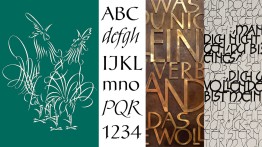Friedrich Neugebauer: Austria’s Calligrapher, Book Artist, and Publisher
Thursday, October 12, 2023, 6:30 - 8:30pm

In a career that spanned 75 years, Friedrich Neugebauer (1911–2005) developed and refined a calligraphic style like no other. With roots that extended back through his own teacher, Rudolf von Larisch, to the Jugendstil and the Wiener Werkstätte, Friedrich worked with a compelling palette of colors, materials, textures, and scales. He created broadsides and manuscript books, signage, sculptures, established a private press, and taught generations of students. Neugebauer’s The Mystic Art of Written Forms (translated into English by our speaker in 1980) is often cited as one of most important manuals of calligraphy ever written. He also published children’s books of the highest artistic merit, and helped to launch the careers of such illustrators as Lisbeth Zwerger
Please join Bruce Kennett for a visual exploration of Neugebauer’s distinctive works, and a glimpse of his life in a small village in the Salzkammergut–Austria’s “Sound of Music” country–as part of the Herb Lubalin Lecture Series.
Registration required. Please note this free event is first-come-first-served, and an RSVP does not guarantee admission.
Book designer, photographer, and teacher Bruce Kennett lives in rural New England. After earning a B.A. in humanities and working as an architect and printer, he moved to Austria to study calligraphy and book design with Friedrich Neugebauer, and later translated Neugebauer’s The Mystic Art of Written Forms. During the 1980s, he was the managing director of Maine’s renowned Anthoensen Press, and since then has maintained his own studio with clients that have ranged from the Folger Shakespeare Library, Boston College Law School, and the Grolier Club to L.L. Bean and the Mount Washington Observatory. In the peaceful surroundings of his country studio, Kennett designs illustrated books and exhibition graphics, and makes large-scale murals of his photographs. He has collected the work of W. A. Dwiggins since 1972, and has been writing and lecturing about him since 1980. His comprehensive biography, W. A. Dwiggins: A Life in Design (Letterform Archive, 2017), captures the inspiring accomplishments and wit of this amazing artist.
Located in the Frederick P. Rose Auditorium, at 41 Cooper Square (on Third Avenue between 6th and 7th Streets)




